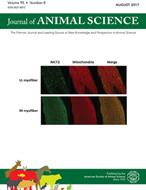-
Views
-
Cite
Cite
A. Suárez-Trujillo, J. S. Crodian, A. M. Shamay, S. J. Mabjeesh, K. Plaut, T. M. Casey, 0853 Interactions among serotonin and circadian systems in the mammary gland, Journal of Animal Science, Volume 94, Issue suppl_5, October 2016, Pages 410–411, https://doi.org/10.2527/jam2016-0853
Close - Share Icon Share
Abstract
The circadian and serotonin systems are reciprocally regulated in the brain and function to maintain homeostasis and respond to internal and external stimuli. Both systems play regulatory functions throughout the lactation cycle in the mammary gland. We hypothesized that the serotoninergic and circadian systems are reciprocally regulated in the mammary gland to mediate mammary homeostasis and respond to metabolic demands of milk synthesis. The objective of this study was to determine whether there is reciprocal regulation among the systems using approaches that encompassed bioinformatics analysis, mammary cell and tissue culture, and temporal expression analysis of mammary gene expression using sheep milk. Bioinformatics analysis of the 2000-bp upstream region of the SLC6A4 (serotonin reuptake transporter, SERT) gene revealed the presence of a canonical E-box sequence (CACGTG) that circadian transcription factor CLOCK:BMAL1 binds. qPCR analysis of steady-state SLC6A4 mRNA in samples isolated from sheep milk fat globules showed that this gene exhibits a circadian rhythm of expression. SLC6A4 pattern of expression was similar to PER2, a core clock gene that is a transcriptional target of CLOCK:BMAL1. Moreover, comparison of PER2 and SLC6A4 temporal expression in wild-type HC11 cells also showed similar expression patterns in this mammary epithelial cell line. In HC11 cultures that carry shRNA that targeted CLOCK, SLC6A4 expression was decreased across all time points (P < 0.05), supporting that the mammary clock regulates this serotonergic factor. To study the effect of serotonin (5-HT) on the mammary clock, mammary explants were prepared from lactating mice and divided into two treatments: control (lactogenic culture media–prolactin, glucocorticoids, and insulin) and 5-HT (lactogenic culture media and 200 µM of 5-HT). Samples were collected every 4 h over a 24-h period. One-way ANOVA of temporal variation within treatments found time had a significant (P < 0.05) impact on BMAL1 expression in the control, but not the 5-HT treated samples, indicating that 5-HT attenuates BMAL1 expression rhythm. PER2 temporal variation was significant in both treatments (P < 0.001), but the differences were due to different time points, indicating that 5-HT shifted the phase of expression rhythm. Together, these data support that circadian and serotonergic systems interact in mammary gland. Further studies are needed to understand the significance of these interactions and how they may affect productivity.





